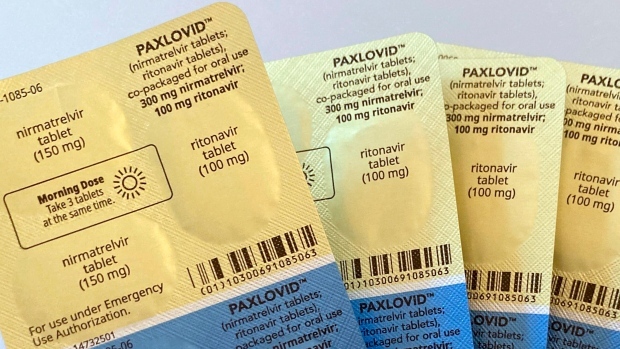'Little being done': Toronto doctor calls on gov't to secure more antibiotics for children amid surge in respiratory viruses
 FILE- Empty shelves of children's pain relief medicine are seen at a Toronto pharmacy Wednesday, August 17, 2022. Pharmacists say Ontario drugstores are facing shortages of common children's pain relievers amid sporadic supply disruptions across the country. THE CANADIAN PRESS/Joe O'Connal
FILE- Empty shelves of children's pain relief medicine are seen at a Toronto pharmacy Wednesday, August 17, 2022. Pharmacists say Ontario drugstores are facing shortages of common children's pain relievers amid sporadic supply disruptions across the country. THE CANADIAN PRESS/Joe O'Connal
One Toronto infectious diseases specialist says the government needs to secure more antibiotics used to treat children right away as “little is being done” to address the drug shortage in Ontario amid a nasty viral season.
“We're seeing surging respiratory viruses like flu, RSV (Respiratory Syncytial Virus), and of course COVID-19, among other respiratory viruses that are circulating. This is in the context of pediatric emergency departments getting flooded and so much pressure on the health-care system,” Dr. Isaac Bogoch told CP24 Tuesday morning.
Health Canada announced on Monday that four pharmaceutical companies -- Sanis Health, Apotex, GSK and Teva Canada – are experiencing shortages of drugs that contain the antibiotic amoxicillin.
The drug is commonly used to treat a range of illnesses in children, including chest and ear infections. The antibiotic comes in a powder for children which pharmacists mix with liquid, and in a pill or capsule for adults.
Health Canada said it will follow up with the companies and will “take action” alongside drug manufacturers, provinces and territories to address supply concerns.
The national health agency added there are eight other drug producers offering medications with amoxicillin that are not currently reporting supply issues.
The drug shortage comes amid a lack of supply of Tylenol and Advil for children in Ontario, which began back in August due to heightened demand and supply chain constraints.

Ontario Pharmacists Association CEO Justin Bates said increased demand for antibiotics in this current viral respiratory season is causing the amoxicillin shortage as well.
“…Unprecedented demand, upwards of 300 per cent over normal seasonal consumption patterns, has led to what we call a demand driven shortage and now it's hitting children's liquid formulation of amoxicillin and we're going to have to look at ways to mitigate that and ration supply, as well as come up with alternatives for parents,” he told CP24 on Monday.
Bates said it could take months to replenish the amoxicillin stock, which is urgently needed now to combat the rise in colds and flu.
“Because it's a prescription-based product and not an over the counter…we expect it (the shortage) to be much more severe in terms of the length, may even go into January to March,” he said.
Ontario's Ministry of Health (MOH) said shortages are expected to last until the end of the year for many products but other drugs can be used as an alternative to amoxicillin.
"The estimated end dates of shortage for several products are currently showing as being in November or December. A number of other antibiotics, funded through the Ontario Drug Benefit (ODB) Program, can be used to treat patients in place of amoxicillin. We encourage patients to speak with their pharmacist or prescriber if they cannot obtain amoxicillin products," a MOH spokesperson wrote in a statement to CP24.com on Tuesday.
Canada isn’t the only country experiencing a shortage. The U.S. Food and Drug Administration is also reporting a lack of amoxicillin due to an increased demand for the drug.
As Ontario copes with drug shortages, many pediatric hospitals across the province are reporting a high number of visits to emergency rooms due to an early surge in illnesses among children.

Ontario’s Chief Medical Officer of Health Dr. Kieran Moore has said that the health system will see a "triple threat" of COVID-19, a bad flu season, and the resurgence of a childhood respiratory virus this fall and winter.
Bogoch told CP24 on Tuesday that it appears little is being done to address the drug shortages since they began in the summer.
“I mean, this is a significant issue and of course the issue with the fever-evading medications is months-long. We saw this issue in the summertime as well. I'm not going to pretend to be a supply chain expert but clearly we've known about this for a while and there looks like there's very little being done to curb this problem,” he said.
Bogoch acknowledged that there is “no quick fix” to obtain more supply but said if the government wants to alleviate pressure off the health-care system then it needs to give parents the tools to care for their children at home.
“So be it the federal government, the provincial government, whatever regulatory body or agency is responsible for providing the citizens and the public with medications, including fever-abating medications and antibiotics, I mean, let's get on it because we still have a long fall and winter ahead and this problem isn't going away,” he said.
CP24 has reached out to Ontario's Ministry of Health for comment.
Until supply is replenished, Bruce County Pharmacist Kristen Watt told CP24, some drugs for adults could be used to treat children but that’s on a case-by-case basis.
“So for pain and fever, we're looking at using adult strength of ibuprofen or acetaminophen and dosing them for kids,” she said.
“But when it comes to antibiotics, that’s a whole other ball of wax. We're going to have to work with the prescribers, we need to understand what we're treating kids for. There are some adult pills and capsules that we might be able to use or we might have to look at alternative antibiotics, go down the line and select other alternatives,” Watt added.
Watt said pharmacists in Ontario are unable to select alternative drugs for their patients, but if they could that would be helpful in keeping patients out of the hospital.
“If we had the patient in front of us knowing their diagnosis, if we could simply select an alternative, but there's a limitation in our practice ability at this time,” Watt said.
In an effort to reduce the number of COVID-19 patients in the hospital this winter, Ontario is considering allowing pharmacists to prescribe the COVID-19 treatment drug Paxlovid to patients.

Bogoch said that is a “perfect strategy” to alleviate pressure on the healthcare system this winter.
“Who better to do this than a pharmacist at a pharmacy. If we can take other complications and other individuals out of the equation and simplify it so someone may have symptoms, go to a pharmacy, get tested, have a positive test and start that Paxlovid safely and quickly, we're clearly doing something right. That is the smart move forward,” he said.
With files from The Canadian Press
CTVNews.ca Top Stories

Montreal man died of aneurysm after waiting 6 hours in ER
A 39-year-old Montreal man died of an aneurysm after spending six hours in an emergency room before giving up and going home.
Racy photos of Bashar Assad discovered after his fall spark ridicule
Bizarre and personal photos of ousted Syrian President Bashar Assad have surfaced from his abandoned residences, sparking ridicule among Syrians who only until recently were persecuted for criticizing his leadership.
Kennedy’s lawyer has asked the U.S. FDA to revoke its approval of the polio vaccine
U.S. president-elect Donald Trump has praised the polio vaccine as the 'greatest thing,' but a lawyer affiliated with Trump’s pick to lead the country’s top health agency has petitioned the U.S. Food and Drug Administration to revoke approval of the vaccine used in the United States
National Police Federation raises concerns over Manitoba’s border reinforcement plans
The association representing RCMP officers said it’s concerned about the province’s plans for more overtime to help patrol the border.
'We called a Code Silver': LHSC goes into lockdown after shooting outside emergency department
The emergency department (ED) doors at LHSC Victoria Campus were being repaired Saturday morning after a person fired a gun into the glass.
'Smoldering myeloma': Breakthrough research could buy time for those at risk of dangerous cancer
Multiple myeloma is an incurable cancer. An estimated 4,000 Canadians are diagnosed each year, according to the Canadian Cancer Society, with an average survival of eight years after diagnosis.
Romney stands by Trump criticism but says MAGA is now the Republican Party
U.S. Sen. Mitt Romney, a frequent Donald Trump critic who will soon retire from Congress, stood by his criticism of the American president-elect’s character but said Trump and his MAGA movement now define the Republican Party.
Feds should consider scrapping controversial digital services tax amid Trump tariff threats: Morneau
If the Canadian government wants to make headway with the incoming U.S. administration, it should look at scrapping some sticking-point policies, such as the controversial digital services tax, former Liberal finance minister Bill Morneau says.
Canada Post union negotiator balks at labour minister's calling for a 'time-out'
This week, Labour Minister Steven MacKinnon announced a 'time-out' in the ongoing Canada Post strike. In a way, Canadian Union of Postal Workers (CUPW) negotiator Jim Gallant says he agrees with that phrasing.































